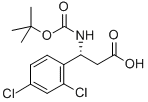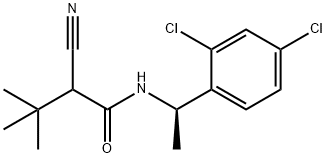(R)-1-(4-CHLOROPHENYL)ETHYLAMINE
Synonym(s):(R)-1-(4-Chlorophenyl)ethylamine
- CAS NO.:27298-99-3
- Empirical Formula: C8H10ClN
- Molecular Weight: 155.63
- MDL number: MFCD00671639
- EINECS: 608-077-8
- SAFETY DATA SHEET (SDS)
- Update Date: 2023-04-23 13:52:06

What is (R)-1-(4-CHLOROPHENYL)ETHYLAMINE?
Chemical properties
Clear colorless to yellowish liquid
The Uses of (R)-1-(4-CHLOROPHENYL)ETHYLAMINE
(R)-(+)-1-(4-Chlorophenyl)ethylamine, is used as an important raw material and intermediate used in organic Synthesis, pharmaceuticals, agrochemicals and dyestuff. It is used as a chiral reagent.
Properties of (R)-1-(4-CHLOROPHENYL)ETHYLAMINE
| Melting point: | 222-224 °C |
| Boiling point: | 232 °C |
| alpha | 23.5 º (C=2, MEOH) |
| Density | 1.110 g/mL at 20 °C(lit.) |
| refractive index | n |
| Flash point: | 115°C |
| storage temp. | under inert gas (nitrogen or Argon) at 2-8°C |
| form | Liquid |
| pka | 8.82±0.10(Predicted) |
| color | Clear colorless to yellow |
| optical activity | [α]/D +26.0±2.0°, c = 5 in ethanol |
| Water Solubility | VERY LOW SOLUBILITY |
| Sensitive | Air Sensitive |
| BRN | 2412317 |
| CAS DataBase Reference | 27298-99-3 |
Safety information for (R)-1-(4-CHLOROPHENYL)ETHYLAMINE
| Signal word | Danger |
| Pictogram(s) |
 Corrosion Corrosives GHS05  Skull and Crossbones Acute Toxicity GHS06  Environment GHS09 |
| GHS Hazard Statements |
H302:Acute toxicity,oral H315:Skin corrosion/irritation H317:Sensitisation, Skin H318:Serious eye damage/eye irritation H330:Acute toxicity,inhalation H401:Hazardous to the aquatic environment, acute hazard H411:Hazardous to the aquatic environment, long-term hazard |
| Precautionary Statement Codes |
P260:Do not breathe dust/fume/gas/mist/vapours/spray. P273:Avoid release to the environment. P280:Wear protective gloves/protective clothing/eye protection/face protection. P284:Wear respiratory protection. P310:Immediately call a POISON CENTER or doctor/physician. P320:Specific treatment is urgent (see … on this label). P330:Rinse mouth. P304+P340:IF INHALED: Remove victim to fresh air and Keep at rest in a position comfortable for breathing. P305+P351+P338:IF IN EYES: Rinse cautiously with water for several minutes. Remove contact lenses, if present and easy to do. Continuerinsing. P405:Store locked up. |
Computed Descriptors for (R)-1-(4-CHLOROPHENYL)ETHYLAMINE
New Products
Tert-butyl bis(2-chloroethyl)carbamate 4-Methylphenylacetic acid N-Boc-D-alaninol N-BOC-D/L-ALANINOL N-octanoyl benzotriazole 3-Morpholino-1-(4-nitrophenyl)-5,6-dihydropyridin- 2(1H)-one Furan-2,5-Dicarboxylic Acid DIETHYL AMINOMALONATE HYDROCHLORIDE 1,1’-CARBONYLDIIMIDAZOLE R-2-BENZYLOXY PROPIONIC ACID 1,1’-CARBONYLDI (1,2-4 TRIAZOLE) N-METHYL INDAZOLE-3-CARBOXYLIC ACID (2-Hydroxyphenyl)acetonitrile 4-Bromopyrazole 5-BROMO-2CYANO PYRIDINE 5,6-Dimethoxyindanone 5-broMo-2-chloro-N-cyclopentylpyriMidin-4-aMine 2-(Cyanocyclohexyl)acetic acid 4-methoxy-3,5-dinitropyridine 1-(4-(aminomethyl)benzyl)urea hydrochloride 2-aminopropyl benzoate hydrochloride diethyl 2-(2-((tertbutoxycarbonyl)amino) ethyl)malonate tert-butyl 4- (ureidomethyl)benzylcarbamate Ethyl-2-chloro((4-methoxyphenyl)hydrazono)acetateRelated products of tetrahydrofuran








You may like
-
 (R)-(+)-1-(4-Chlorophenyl)ethylamine CAS 27298-99-3View Details
(R)-(+)-1-(4-Chlorophenyl)ethylamine CAS 27298-99-3View Details
27298-99-3 -
 1975-50-4 98%View Details
1975-50-4 98%View Details
1975-50-4 -
 2-HYDROXY BENZYL ALCOHOL 98%View Details
2-HYDROXY BENZYL ALCOHOL 98%View Details
90-01-7 -
 2-Chloro-1,3-Bis(Dimethylamino)Trimethinium Hexafluorophosphate 221615-75-4 98%View Details
2-Chloro-1,3-Bis(Dimethylamino)Trimethinium Hexafluorophosphate 221615-75-4 98%View Details
221615-75-4 -
 61397-56-6 CIS BROMO BENZOATE 98%View Details
61397-56-6 CIS BROMO BENZOATE 98%View Details
61397-56-6 -
 14714-50-2 (2-Hydroxyphenyl)acetonitrile 98+View Details
14714-50-2 (2-Hydroxyphenyl)acetonitrile 98+View Details
14714-50-2 -
 118753-70-1 98+View Details
118753-70-1 98+View Details
118753-70-1 -
 733039-20-8 5-broMo-2-chloro-N-cyclopentylpyriMidin-4-aMine 98+View Details
733039-20-8 5-broMo-2-chloro-N-cyclopentylpyriMidin-4-aMine 98+View Details
733039-20-8
Statement: All products displayed on this website are only used for non medical purposes such as industrial applications or scientific research, and cannot be used for clinical diagnosis or treatment of humans or animals. They are not medicinal or edible.